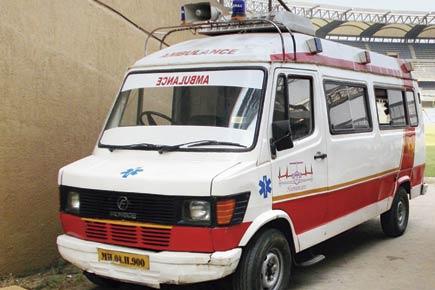Lacking gear as basic as masks, experts say drivers and cleaners of ambulances used to transfer patients between hospitals may catch infections; at least 2,598 people have tested positive for swine flu in the city so far and 43 have died

With at least 2,598 people having tested positive for swine flu in the city this year and over 43 deaths taking place, the lack of safety measures taken by tertiary care hospitals (which providing specialised treatment and specialists) to protect health workers is worrying.
ADVERTISEMENT

The ambulances in question are used largely to ferry patients between the four BMC-run tertiary care hospitals. Picture for representation
Ambulance drivers, for instance, have been ferrying H1N1 positive patients between the Kasturba, Sion, Nair and KEM Hospitals, but nothing has allegedly been done to ensure that they do not catch the infection because of sharing space with the patients.
While the staff members of the ambulance departments at the hospitals (these ambulances only ferry patients between hospitals and between wards of a hospital) said that they do not get masks, or influenza vaccinations to protect them from the virus, experts said that there is a high probability of them getting infected.
As of now, there are a total of four Brihanmumbai Municipal Corporation (BMC)-run ambulances plying between the four hospitals. While Kasturba Hospital is dependent on an ambulance which is on contract, the other three have one ambulance each to ferry the patients from one hospital to another according to the doctor’s requirements.
While staff members have been working in three shifts, an ambulance, at all times, has a driver and a cleaner to ferry the patients every day. Apart from being transferred, the patients are also taken to other tertiary care hospitals for various tests in case the facility isn’t available at the hospital. Considering the traffic, the ambulance makes anywhere between 7-8 trips a day, 2-3 of which are to carry patients having viral diseases, including swine flu.
Fending for themselves
When mid-day contacted the employees driving the ambulances, they confirmed that even basic gear, like masks, is not available for them, and some of them have bought masks on their own.
A staff member from Nair hospital, who has been driving an ambulance for more than two decades, said that since H1N1 is a new virus, there is not much awareness among the drivers, and neither have the doctors tried to create any.
“Earlier we used to get call letters with red circles around the names of some patients. That would alert us that the patient has an infectious disease and we should take precautions. When new doctors came around 7 years ago, we stopped getting such intimations.
Most of the staff members are uneducated and they don’t understand the importance of precaution, nor do the doctors sending patients make them aware of the same,” he said. Another driver from Sion Hospital said that if there is a possibility of them catching the infection, they should be informed by the doctors in advance about the kind of patients who are ferried.
“All that we get is a name and other minor details. We aren’t told what the patient is suffering from and why he is being transferred. As it is, there are no masks available and we literally have to go and beg the staff members, or nurses, for the masks at times because we aren’t allotted any,” said the staff member.
Expert speak
Dr Pradip Shah, MD (Internal medicine) at Fortis Hospital said precautions need to be taken by any person who shares a closed space with a swine flu-positive patient, as there is a chance of catching the infection.
“The virus doesn’t survive in air for too long, but it can definitely spread faster in close proximity like a vehicle or a room. Healthcare workers, especially, need to wear masks while dealing with the patients, as well as take advice from their respective doctors for taking the influenza vaccine to safeguard themselves from the infection,” said Shah.
 Subscribe today by clicking the link and stay updated with the latest news!" Click here!
Subscribe today by clicking the link and stay updated with the latest news!" Click here!






